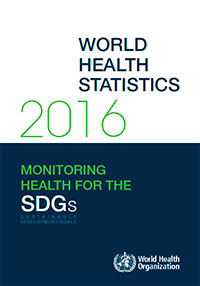|

|
WORLD HEALTH STATISTICS 2016:
MONITORING HEALTH FOR THE SDGS
WHO, 2016, 136 pages
|
http://www.who.int/gho/publications/world_health_statistics/en/
Доклад "Мировая статистика здравоохранения",
публикуемый ежегодно с 2005 года, является авторитетным источником
информации о здоровье людей в мире.
Он содержит данные из 194 стран по целому ряду показателей
в отношении смертности, заболеваемости и систем здравоохранения,
включая ожидаемую продолжительность жизни; заболеваемость и смертность
от основных болезней; медико-санитарные услуги и виды лечения; финансовые
инвестиции в здравоохранение; а также факторы риска и формы поведения,
оказывающие воздействие на здоровье.
В докладе этого года приводятся новейшие данные в отношении
задач, касающихся здоровья, поставленных в рамках Целей в области
устойчивого развития (ЦУР), принятых Генеральной Ассамблеей Организации
Объединенных Наций в сентябре 2015 года. Доклад указывает на наличие
существенных пробелов в данных, которые должны быть заполнены, чтобы
можно было осуществлять надежный контроль за ходом работ по достижению
ЦУР, связанных со здоровьем. Представлен всесторонний обзор новейших
ежегодных данных в отношении задач ЦУР, связанных со здоровьем,
свидетельствующих о масштабах данных проблем.
В то время как Цели тысячелетия в области развития были
ориентированы на выполнение к 2015 году узкого круга задач в области
здравоохранения, касающихся конкретных заболеваний, ЦУР охватывают
период до 2030 года и носят гораздо более широкий характер. Например,
в число ЦУР входит широкая цель в области охраны здоровья - обеспечение
здорового образа жизни и содействие благополучию для всех в любом
возрасте, которая призывает к достижению всеобщего охвата услугами
здравоохранения.
В докладе показано, что многие страны еще далеки от
обеспечения всеобщего охвата услугами здравоохранения, оцениваемого
с помощью показателя доступности 16 основных услуг, особенно в Африканском
регионе и Регионе Восточного Средиземноморья. Кроме того, значительно
число людей, пользующихся этими услугами, сталкиваются с катастрофическим
уровнем расходов на медицинское обслуживание, который определяется
как расходы на оплату медицинских услуг за счет собственных средств,
превышающие 25% от суммы общих расходов семьи.
Также, в докладе приводятся данные, указывающие на неравенства
в доступе к услугам здравоохранения в рамках стран - между наименее
обеспеченными жителями данной страны и средним уровнем по стране
в отношении некоторых услуг в области охраны репродуктивного здоровья,
а также охраны здоровья матери и ребенка.
CONTENTS
Executive summary
Abbreviations
Introduction
1 The 2030 Agenda - a new impetus for health monitoring
2 Implications of the SDGs for health monitoring - a
challenge and an opportunity for all countries
2.1 Scope - an agenda for all countries
2.2 Contents - all major health areas are included
2.3 Equity - the need for disaggregated data
2.4 Multisectoral data - health-related risk factors and determinants
2.5 Country monitoring - data gaps and capacity
2.6 Regional and global monitoring - mechanisms and estimates
2.7 Review - using data for improved implementation
3 Monitoring the health goal - indicators of overall
progress
3.1 Life expectancy - major gains but still large differences
3.2 Healthy life expectancy - gaining healthy life years
3.3 Premature mortality - focusing on deaths among those under
70 years of age
3.4 Data gaps - most deaths not registered
4 Universal health coverage - at the centre of the health
goal
4.1 UHC coverage index of essential health services - a new summary
measure
4.2 Inequalities in coverage - towards an integrated assessment
4.3 Financial protection - measuring the impact of out-of-pocket
payments
4.4 Data gaps - regular UHC monitoring is possible
5 Equity - leave no one behind
5.1 Sex - major differences between men and women for many indicators
5.2 Age - data should cover the full life course
5.3 Socioeconomic status - major disadvantages for the poorest
and the least educated
5.4 Place of residence - focus on geographical differences within
countries
5.5 Migrants and minorities - requiring special efforts
5.6 Data gaps - disaggregation is a crucial data challenge
6 SDG health and health-related targets
6.1 Health targets - 13 targets and 26 proposed indicators
6.2 Health-related targets in other goals - many targets linked
to health
6.3 Situation in 2016 - a sketch based on global data
Reproductive, maternal, newborn and child health
Infectious diseases
Noncommunicable diseases and mental health
Injuries and violence
Health systems
6.4 Data gaps - need for strong country health information systems
Annex A: Summaries of the SDG health and health-related
targets
Explanatory notes
Target 3.1 Maternal mortality
Target 3.1 Births attended by skilled health personnel
Target 3.2 Child mortality
Target 3.3 HIV
Target 3.3 Tuberculosis
Target 3.3 Malaria
Target 3.3 Hepatitis
Target 3.3 Neglected tropical diseases
Target 3.4 Noncommunicable diseases
Target 3.4 Suicide
Target 3.5 Substance abuse
Target 3.6 Road traffic injuries
Target 3.7 Sexual and reproductive health
Target 3.9 Mortality due to air pollution
Target 3.9 Mortality due to unsafe water, unsafe sanitation and
lack of hygiene
Target 3.9 Mortality due to unintentional poisoning
Target 3.a Tobacco use
Target 3.b Essential medicines and vaccines
Target 3.c Health workforce
Target 3.d National and global health risks
Target 2.2 Child stunting
Target 2.2 Child wasting and overweight
Target 6.1 Drinking-water
Target 6.2 Sanitation
Target 7.1 Clean household energy
Target 11.6 Ambient air pollution
Target 13.1 Natural disaster
Target 16.1 Homicide
Target 16.1 Conflicts
Annex B: Tables of health statistics by country, WHO
region and globally
Explanatory notes
Annex C: WHO regional groupings
|

